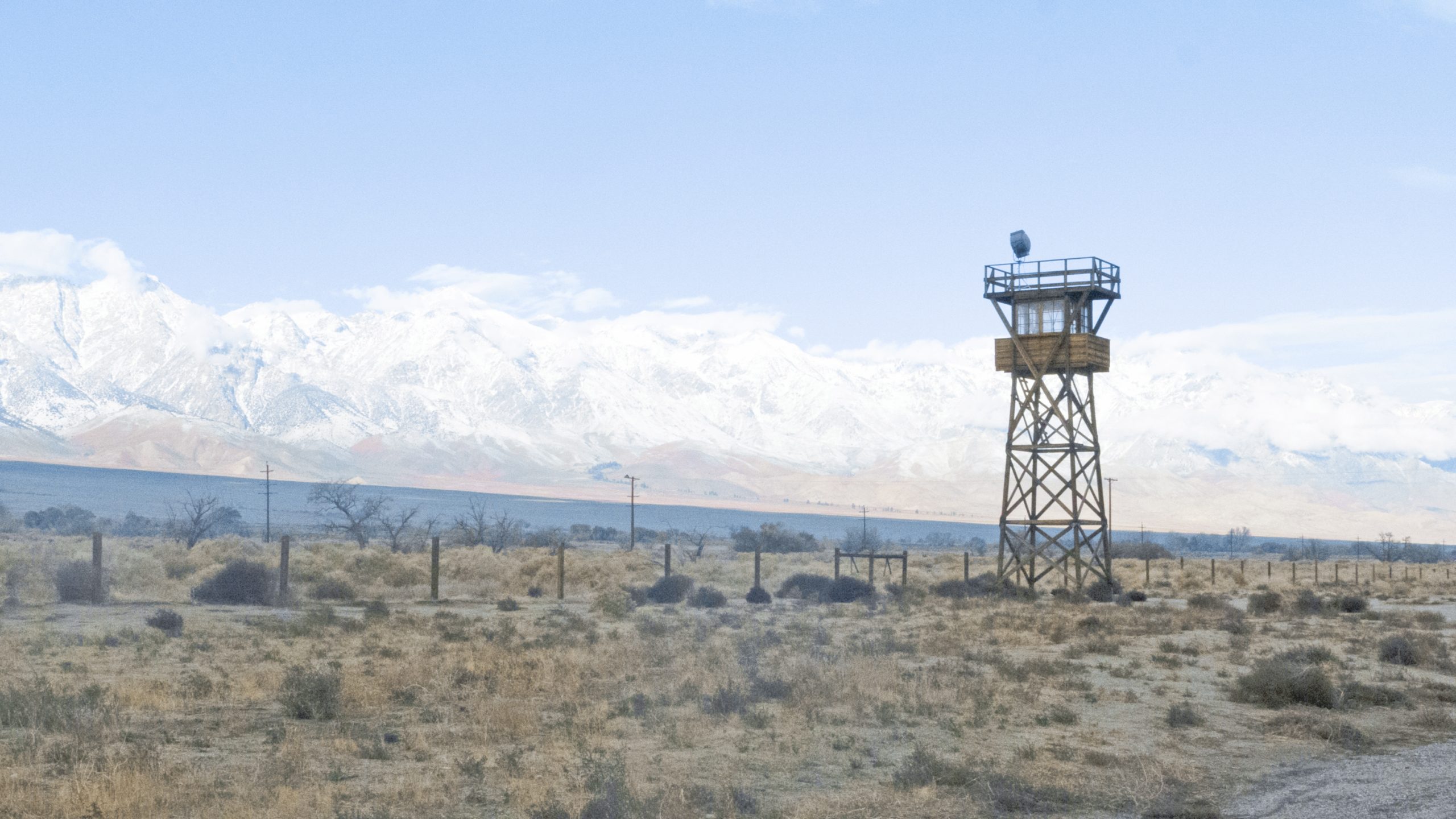This guard tower at Manzanar now keeps watch over the former WRA Center, the sparse landscape and the mountains.
Onscreen, ‘Manzanar, Diverted’ examines the intersections of race and history. Between the frames, it centers three generations of Japanese American female activists.
By Lynda Lin Grigsby, Contributor

Ann Kaneko spent five years making “Manzanar, Diverted.”
Ann Kaneko is driving back to Los Angeles from the Mammoth Film Festival, somewhere between Big Pine and Independence. Big country stretches beyond Highway 395 where the Inyo and Sierra Nevada Mountains tower over the valley.
The road from Mammoth takes her right to Manzanar, so she plans to drop in. The casual way she says this implies a sense of intimacy with the historic site — like it is a relative’s house, and she wants to stretch her legs and say hello to all the aunties and uncles. The closeness between Kaneko and the place grew over five years as she worked on her new documentary, “Manzanar, Diverted: When Water Turns to Dust.”
The stories of land and water use, the forced removal of Native Americans and the incarceration of Japanese Americans all converge in this place.
“The intersectionality of the film emphasizes that we are all in this together,” says Kaneko. She stops to gas up her silver Prius at the same station in Mojave every time she makes this trip because prices here are cheaper than in Los Angeles.
She considers herself an educator first, both as an independent filmmaker and a media studies teacher at Pitzer College in Claremont, Calif. Her camera’s focus makes her an activist and a sorority member of the intergenerational Japanese American activists featured in “Manzanar, Diverted.”
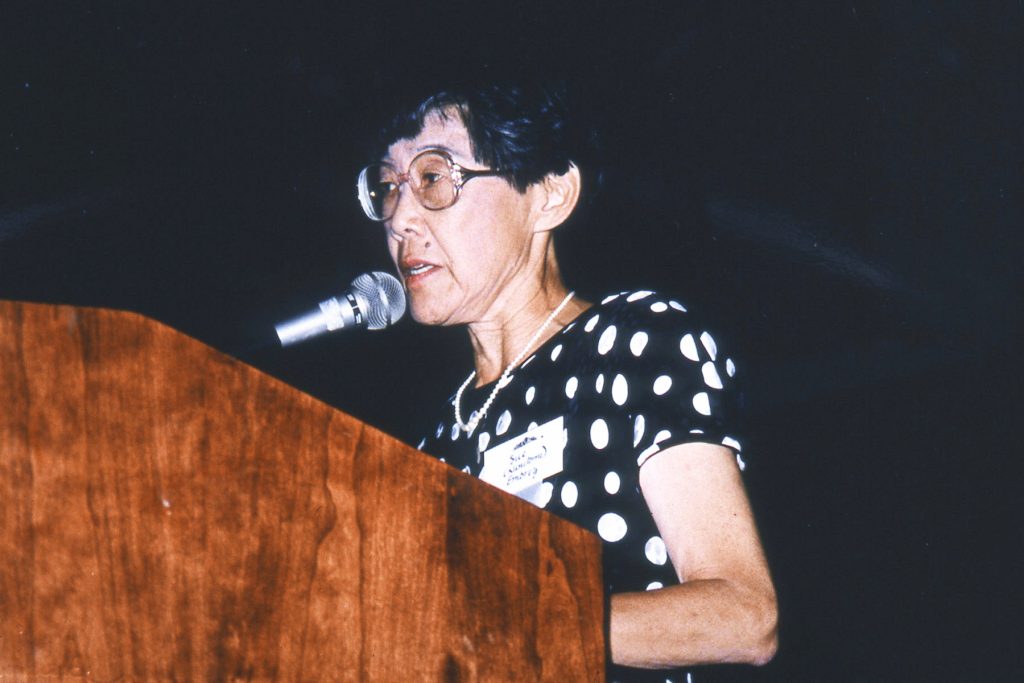
Sue Kunitomi Embrey
Kaneko is Sansei, the connection between Sue Kunitomi Embrey, the Nisei activist and longtime chair of the Manzanar Committee, and her Yonsei granddaughter, Monica Mariko Embrey, whose passionate spoken words about environmental justice can spur a sudden onset of goosebumps.
Many stories have sprung from the dust of Manzanar. Its emotional and psychic toll has been combed through and picked apart, so before making this film, Kaneko often wondered what is new to tell?
She drives past the guard tower many times on the road to Mammoth in search of majestic peaks and crisp air. The open land surrounding Manzanar in the Owens Valley inspires awe — like a wilderness unchecked.
Nature is, as poet John Ruskin once described, a painting for us. A closer look tells a different story.
In her research, Kaneko discovered the Los Angeles Department of Water and Power (DWP) owned almost all the land in the Owens Valley, including Manzanar. Before Japanese Americans were incarcerated on the site, Native Americans were violently forced out in order to tap the most precious resource — water. To supply water to Los Angeles residents, aqueducts slowly siphoned from the valley, turning water to dust.
Suddenly, the nature painting along the highway and the dust storms often depicted in World War II camp photos and videos eerily rising from the ground look like a vengeful spirit released on vulnerable people.
In the memory of her loved one, Sue Embrey, a former Manzanar incarceree, coughs and coughs.
It was a dry and persistent cough, often aggravated by the Santa Ana winds that rustle branches outside her Echo Park home and stir up memories of her incarceration. Sue Embrey hated the wind.
She died in 2006 from inhaling air pollution released in the choking dust over Owens Lake, says Monica Embrey. The Los Angeles Aqueduct drained the lake’s precious snowpack and spring water.
Since 1926, the lake has sat dry with pollutants settled on the surface, ready to be picked up by the vengeful wind. The lake was drained so that Los Angeles residents could fill swimming pools and water thirsty lawns. This is not to make anyone feel guilty, an environmentalist insists in the film, it’s to point out the disconnect between turning on a faucet and knowing where the water comes from.
It’s about knowing the impact on people and a sacred place like Manzanar, so traumatizing that a breeze could transport Sue Embrey back behind barbed wire, but also so important that she would fight to designate the place a national historic site and lead people back every year in a pilgrimage.
Kaneko and the Embreys want you to hear what Buddhist Zen Master Thich Nhat Hanh called the sound of the Earth crying within us.
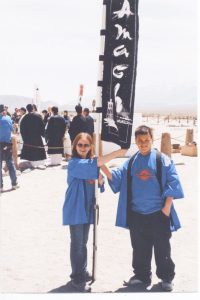
Monica and Mike Embrey attended many Manzanar pilgrimages.
“I think of ways in which environmental injustice plays out is very much the heart of my work and part of why I’m so committed to and dedicated to ensuring that communities of color and low-income households, women and children are able to see justice,” says Monica Embrey, senior associate director of national energy campaigns for the Sierra Club.
At her desk in her home less than a mile away from her grandmother’s house where the Manzanar Committee was born and where her dad, Bruce Embrey, carries on the legacy, Monica Embrey has a picture of her grandmother and a Post-it note handwritten with an enduring message: “Love you.”
From this desk, she attends many virtual meetings — still a necessity in the pandemic — on how to ensure the burden of environmental pollution does not continue to fall on communities of color.
“Activism is its own energy, its own impulse,” said Char Miller, professor of environmental analysis and history at Pomona College, where former student Monica Embrey wrote her senior thesis on water and colonial history in Manzanar and the Owens Valley. “But its origins, in Monica’s case, are a partial result [of] bearing witness to her family’s engagement in and with the world. But it is also driven by her convictions about how to confront the inequities that persist — and new ones that erupt.”
Few other families, Monica Embrey jokes, have an annual family reunion on historic land with hundreds in attendance. Isn’t she lucky? She grew up always within earshot of the latest community news and coalition effort, so even if she isn’t directly from the land that held her grandmother prisoner, she is still born from it.
At a Feb. 4 virtual meeting of the South Coast Air Quality Management District, the agency charged with regulating sources of air pollution in Southern California, many residents took up the public comment portion of the meeting to report on an overwhelming odor of decaying animal carcasses seeping out from rendering plants in their neighborhoods and air pollution coming from the clog of ships in the ports of San Pedro and Long Beach.
One of the Sierra Club’s priorities is to allow affected community members to tell their own stories. It is an intentional tactic inspired in part by the redress movement when Nisei like Sue Embrey unbosomed their memories about the camps before the Commission on Wartime Relocation and Internment of Civilians (CWRIC).
“The period I spent in Manzanar was the most traumatic experience of my life,” said Sue Embrey at the Aug. 5, 1981, hearing. “It has influenced my perspective as well as my continuing efforts to educate, persuade, and encourage others of my generation to speak out about the unspeakable crime.”
With the picture of her grandmother looking on, Monica Embrey tries to safeguard the same space for vulnerable communities to speak out.
“There is something so profoundly powerful when people can tell their stories and speak their truth,” she says.
Call her a contrarian. Kaneko always tries to push the boundaries of storytelling.
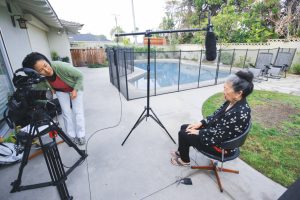
Ann Kaneko conducts an interview.
“Why bother just doing the same old thing everyone else has done?” she says. “That’s boring.”
You can see that in “Manzanar, Diverted” when the camera focuses on an anthill and then zooms out to a sweeping drone footage of the Manzanar monument, a sentinel against the background of the Sierra Nevada mountains described in “A Farewell to Manzanar” as “purple when the sun dropped and so sharply etched in the morning light the granite dazzled almost more than the bright snow lacing it.”
This is only her second film about the Japanese American World War II experience. Her 2012 short film “A Flicker in Eternity” tells the coming-of-age story of Stanley Hayami from an idealist teenager to 442nd Regimental Combat Team soldier.
Her reluctance to make a film that overlapped with her own family’s incarceration history — Rohwer and Jerome — was in part because she wondered what new story could be told, especially about Manzanar, arguably the most iconic of the camps?
Before she became a filmmaker, young Kaneko visited Manzanar with her parents and read that the camp was built on Los Angeles DWP land, but she did not know what that meant. How could she not know? Her family has lived in Los Angeles for three generations, and she considers herself to be smarter than the average bear.
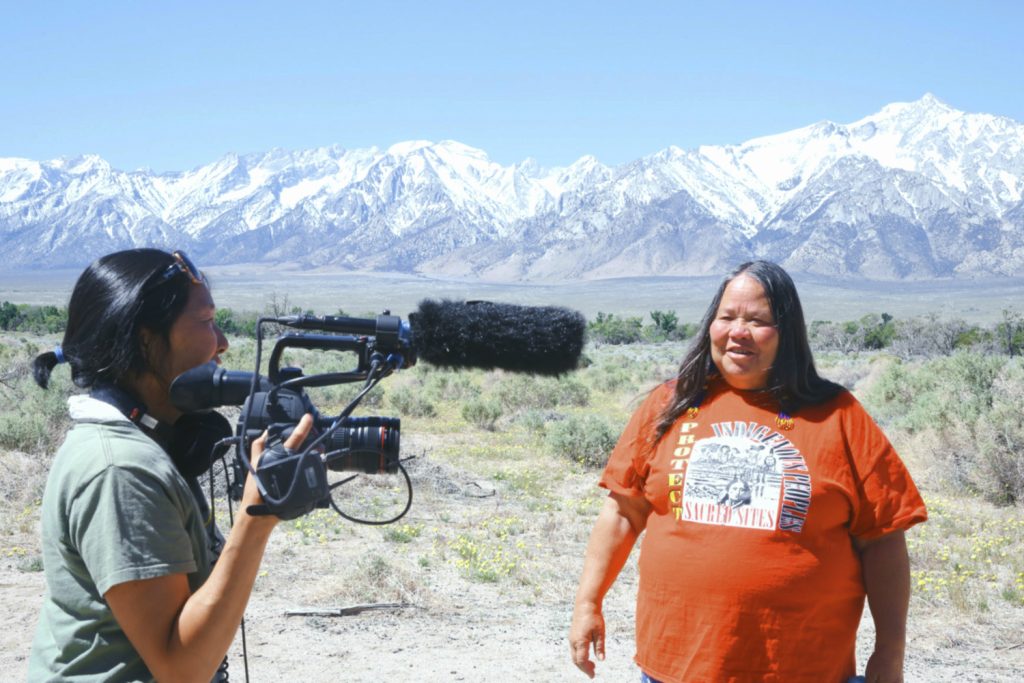
“She tirelessly pursued her ideas and explored related avenues until she found what she was looking for,” said Kathy Jefferson Bancroft (right) about filmmaker Ann Kaneko, left.
The disconnect is intentional. That is how history is taught, says Kathy Jefferson Bancroft, the Lone Pine Tribal historic preservation officer, who is featured in the documentary. It is a deliberate sectioning off and sanitizing of intersecting histories.
“We carry this with us through our lives unless somebody or some experience wakes us up to the fact that these are all of our histories,” says Bancroft.
In Buddhism, Thich Nhat Hanh calls it interbeings, the belief in which we live in connection to all others — there is no you or me, just us. When this connectivity is severed, we risk atrocities both to each other and to the Earth.
In 1863, the U.S. military violently forced the Newe and Paiute people off their land in the Owens Valley. They were forced to take a 200-mile journey to Fort Tejon, so the government could take control of the land and water. Many Owens Valley Native Americans died on the journey. The survivors came back because they were of the land.
The land bore witness to another forced removal in 1942, this time to Manzanar.
“It was like watching another vanquishment,” say Beverly Newell, Bancroft’s aunt, in the film, about the Japanese Americans coming into the valley.
The film layers footage of the valley’s indigenous people in moments of joy with clips of Japanese Americans doing the same around their barracks during WWII. This is Kaneko’s way of reminding us we are in this together.
Between the frames, the connectivity of these intergenerational female activists is what sets this film apart.
“I think that’s what’s so great about Ann’s work,” said Bruce Embrey. “Highlighting Kathy’s work and passion for her people, showing how we are stronger together is just so important to help keep persevering and working to make our country a better place.”
She likes to make things, says Kaneko, so if she were to make pots instead of films, the pots would likely be deconstructed or reimagined in ways that make the everyday household item seem new again.
Is she an activist? She turns the word over with her tongue, tries it on, and decides it does not fit. She is an educator.
It’s a mindset that she carries on from her mother, Masako Kuratomi Kaneko, whose heart’s desire to become an educator was thwarted by the forced removal. Her mother helped pay for her younger sisters’ education. When she received her reparations money, she gave most of it away to educational institutions and told her daughter to be who she wanted to be. Make films, don’t worry. These were opportunities she did not have for herself.
So, Kaneko makes an intimate film about the history of the Owens Valley in her own style and tells a story about the place differently.
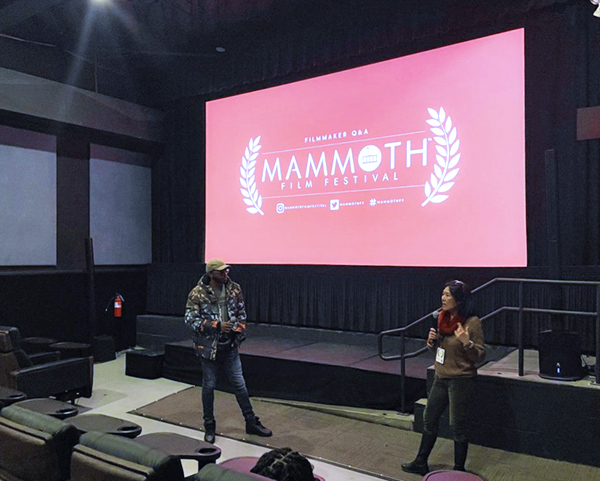
Ann at the Mammoth Film Festival
At the Mammoth Film Festival, about 20 people attend in the waning grip of Omicron. The resort town can feel exclusive, like a Hollywood offshoot except with snow, a lot of it heaped on the side of the roads on a sunny day in February.
It’s one of the rare opportunities these days to watch her film in a darkened theater with a real audience. Kaneko looks for brief cameos of the back of a little girl with pigtails.
Her daughter Ceiba, 11, appears in the film as mostly a sprite-like presence flitting through in one scene and eating a persimmon in another while standing near the aqueduct.
Making this film was the first time Kaneko brought her daughter to work and placed her within earshot of discussions about intersecting histories and environmental justice, as told by intergenerational female activists. Bancroft is like her auntie now whenever they return to Owens Valley.
Ceiba is not from the land, but she is born from it.
For more information, visit www.manzanardiverted.com.

